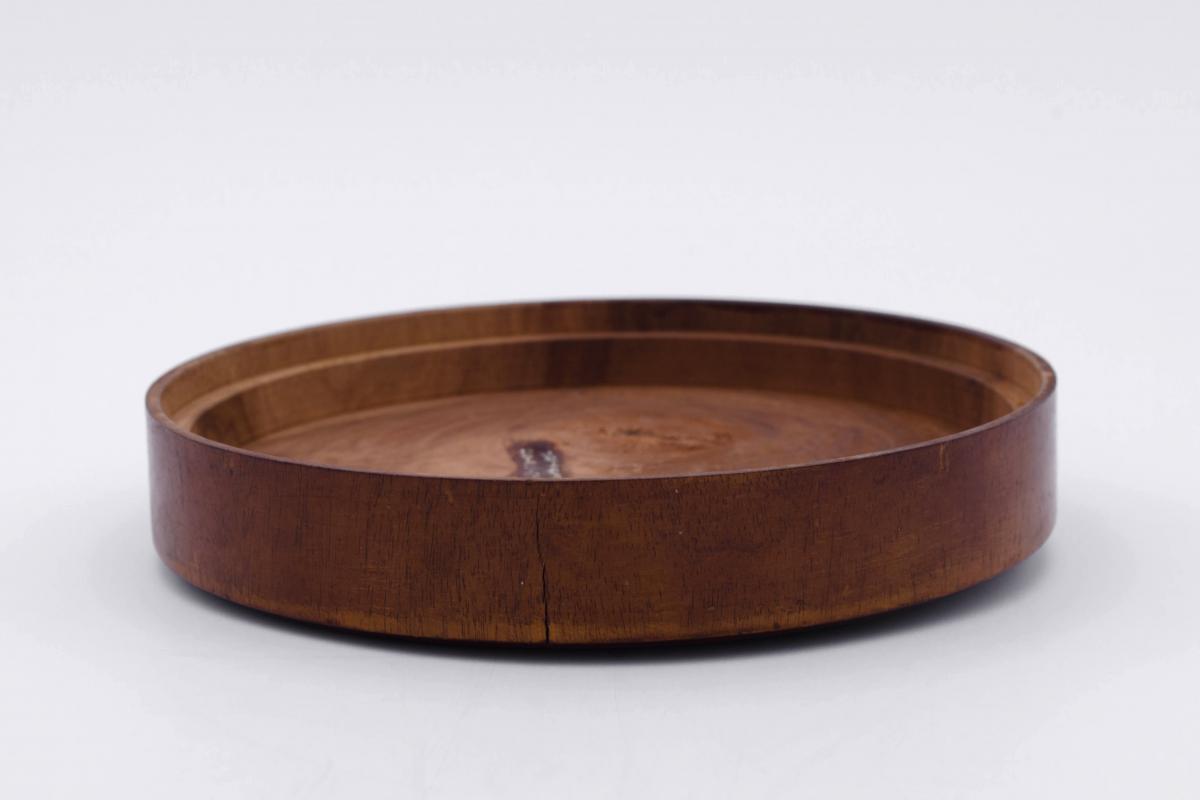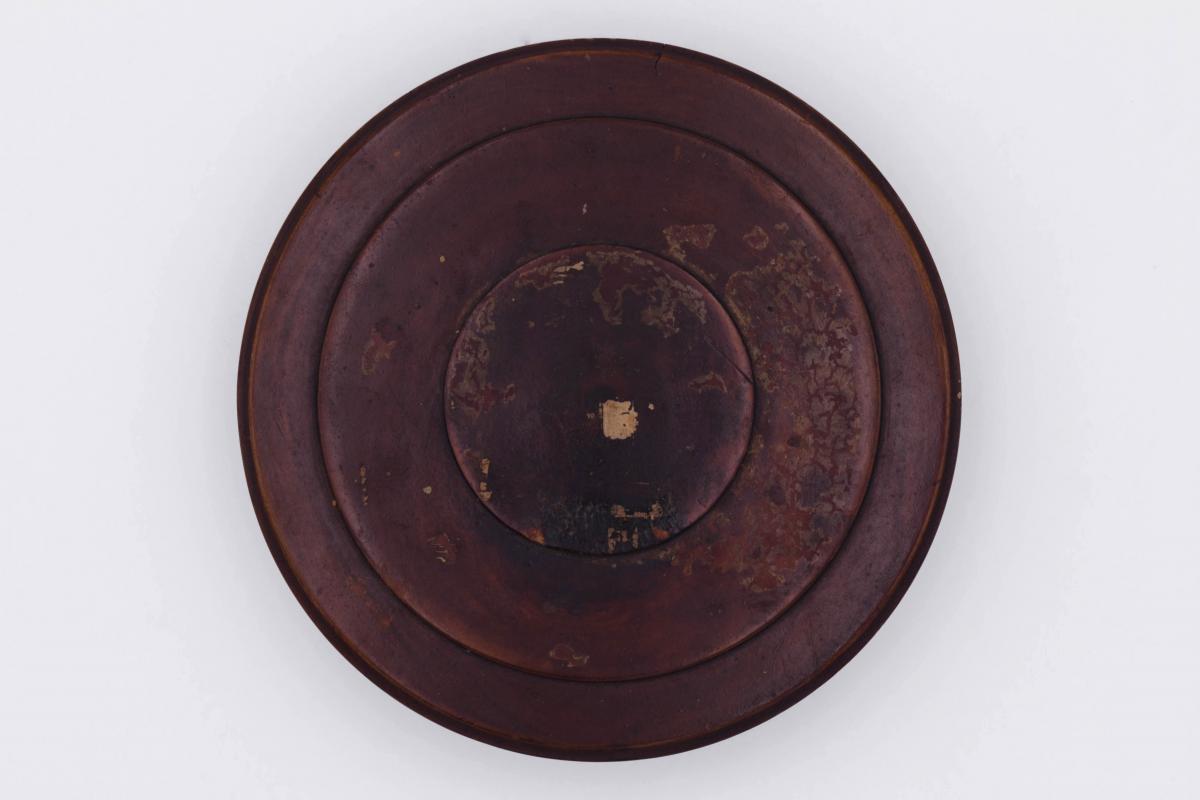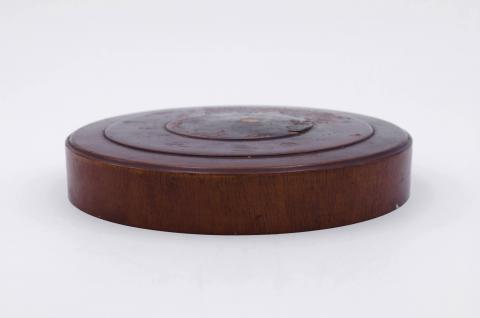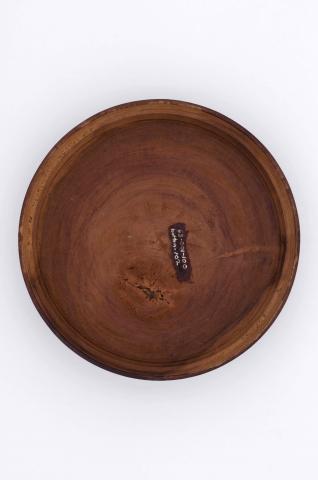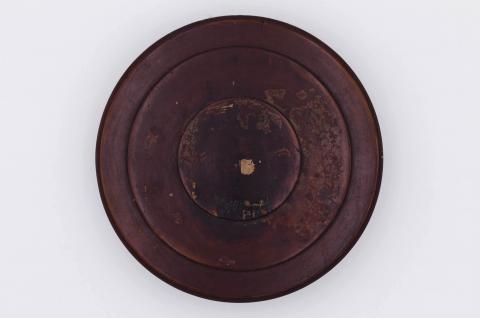‘Umeke la’au (wooden bowl)
Wood Bowl Lid (lid for bowl # 63-001-102). Height: 1 1/2 inches, Width: 7 1/4 inches, Color: Brown. This lid has three rings carved at the top. There are yellow marks at the top, and a brown spot. There is a crack on one side of the lid. Inside, there is another crack, and there is also a trace of a key that has been made with some kind of sharp instrument.
The hardwood most commonly used to make ‘umeke la’au was the kou (Cordia subcordia), whose characteristics of growth range from coastal to kula (dry low land) regions of the island. This growth trait makes this tree a perfect candidate for the creation of wooden bowls as it could be grown as a single tree or as groves near the living areas of kānaka, making it an easily accessible resource. Other hardwoods used to make ‘umeke la’au were: Kamani (Calophyllum inophyllum), Milo (Thespesia populnea), Neneleau (Rhus semialata) and Ohi’a (Metrosideros polymorpha). ‘Umeke la’au were preserved in families and handed down generation to generation (Bringham, 1908). Because of its importance and use there were different names given to different types of bowls. Those names include: ʻumeke pakaka, ʻumeke ipu kai, ʻumeke kumauna, ʻumeke palewa, ʻumeke kuʻoho, ʻumeke puahala, ʻumeke kepakepa, ʻumeke ʻopaka.
When a wooden bowl was broken or cracked, methods were used to mend the broken bowl.
Pahonohono (Repairing)
cracks and breaks in wooden bowls were repaired using a few different methods. (Kekahuna, describes 6)
- Pewa- Rectangular piece of wood of the same kind as the bowl with an angular middle construction like that of an hourglass. An average piece of about 2 inches long by 1 inch wide at the ends and 0.7 inch across the middle construction (butterfly).
- Huini / kui laʻau- A wooden peg made of kauila or other hard wood. Is about 1 inch long and 0.5 inch wide at its outer end, and the other end is brought to a sharp point. Holes are bored with a bone awl, termed kui iwi, and the beg tapped in. The pegs are inserted at a slat across cracks, and they are used with hourglass shaped interest or poho (patches) to tighten them.
- Kepa / kepakepa- Wedge-shaped pieces of hardwood. They average about 0.5 - 0.15 inch at the outer end and are brought to a wedge point at the inner end. The depth depends on the thickness of the bowl at the point of repair. The wedges are hammered in obliquely across cracks and arranged to form a zigzag pattern along the crack, or, as Kekahuna pits , are “like an ascending road / he mea alanui piʻi keʻano”
- Poho- A wooden patch shaped to fit into a hollow part that has rotted or broken out. The rotted part is trimmed to form even edges and the patch shaped to fit it. Sometimes wooden pegs are driven in on a slant around the edges of the patch, or wedges are driven in across the joined edges. IF the patch is large, the hourglass inserts are used across the joined edges in the same way as in mending cracks.
- Kiki- A plug of the same wood as the bowl, shaped like the kepa wedge but the outer end longer. Such wedges are fitted into cracks which are slightly open
- Aha / aha maka- Coir cord with which the edges of cracks are sewn together. Paired holes are bored with a bone awl right through the bowl on each side fot eh crack, as in the gourd bowls. IF crossed stickers are made to form lozenges, the lozenges are likened to the meshes (maka) of a net and the technique receives the name of the ʻaha maka
Hawaii


